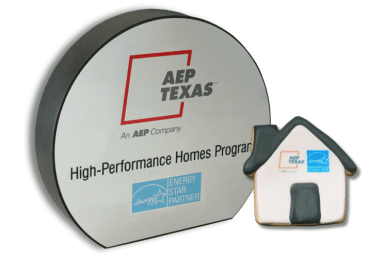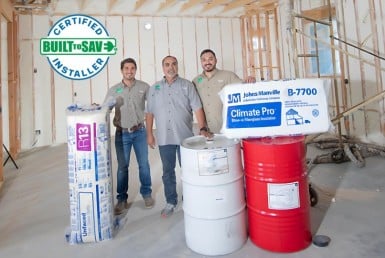Are You Leaving Money on the Table?
Whether you are a builder or homeowner, we guarantee it will be worth your time to read this article—especially if you are not taking advantage of tax credits or incentives for making your home energy efficient.
FOR HOMEOWNERS
If you made your home more energy efficient in 2020 by installing such things as solar panels, solar water heaters, geothermal heat pumps, small wind turbines, and fuel cell property, or energy efficient products like windows, doors, insulation, and HVAC upgrades, you may be entitled to a sweet tax credit for your investment. Currently, there are two energy tax credits available for 2020 Tax Returns: the Residential Energy Efficient Property Credit for renewable energy sources and the Non-Business Energy Property Credit for energy efficient products and systems installed in the home.
These are nonrefundable tax credits, which means you can’t get more money back in tax credits than you pay in federal income taxes (your tax liability). But here’s what is great: what makes a tax credit better than a tax deduction is that a tax credit reduces your tax liability by one dollar for every dollar of credit you get versus a tax deduction that only reduces the amount of taxable income which is what is used to calculate your tax liability. That’s what makes tax credits awesome. And if you are NOT claiming these on your taxes, you are missing out. The good news is that it’s not too late to include them on your 2020 tax return. And the even better news is that if you missed these credits in prior years, they may be retroactive for up to three years.
HOW TO CLAIM A TAX CREDIT
You will need to file a 1040 tax form to get the energy efficiency tax credit. Note that you can NOT claim the energy efficiency tax credit using the 1040EZ form or the 1040A form. Also, it is important to know that you will need to file Form 5695 with your return and get a Manufacturer’s Certification Statement, which is basically a signed statement from the manufacturer stating that the product or component in question qualifies for the tax credit. The certification can usually be found on the manufacturer’s website, or you can call them and get it. You don’t have to submit the certification, but you must have it for your tax records. (It must be mentioned that the information contained here is not meant to be professional or legal advice. We are not tax professionals, so be sure and consult with your tax advisor about the tax credits.)
HOW MUCH MONEY ARE WE TALKING ABOUT?
If you qualify for a tax credit, or how much of a tax credit you qualify for, will depend on several factors, such as the following: the type of home; the year the equipment was put in place; the type of improvement made; the amount you invested; and the applicable percent of the cost of qualified property, or if the credit has a limit. The best place to get an accurate answer on how much money you can expect from the available tax credits is to go directly to the IRS website.
REBATES FOR HOMEOWNERS
Here’s something you may not know. If you are getting ready to buy a new natural gas water heater, you’ll be happy to know you can now save $100. And if you’ve done your homework and are getting ready to buy a new tankless or super high-efficiency natural gas water heater, you can save $650. But that’s not all. Right now, there are additional rebates from Texas Gas Service if you are purchasing some of these appliances as well: natural gas dryers, ranges, or backup power generators. Rebates run from $100 to $500, depending on the appliance. These rebates apply to residential customers living in the city limits of most cities in the Rio Grande Valley and are available on a first-come, first-served basis, subject to availability of program funds. Go to www.TexasGasService.com/Rebates for more information. And builders—good news—if you sell your homes equipped with these specific appliances, you’ll be happy to know that you are eligible for rebates, too.
FOR BUILDERS
The rewards for those that buy energy-efficient homes are many and huge: lower utility bills, tighter quality construction, a more comfortable home with better indoor air, and peace of mind, to name a few. But what’s in it for the builder? Well, if you mean what else besides the pride, reputation, and competitive advantage of being one of the best builders in the market, it would be the generous rebates from the local utility companies. In addition to the rebates from Texas Gas Service on new qualifying natural gas appliances mentioned above, two other utility companies offer generous incentives for builders who build energy efficient, high-performance homes.
Magic Valley ELECTRIC Cooperative (MVEC) Rebates
Magic Valley Electric Cooperative (MVEC) pays cash incentives to builders who certify homes in the BUILT TO SAVE® program in MVEC communities. Rebates are available on a first-come basis and start at $200 per home. The more energy efficient the home is, the higher the incentive. Visit www.MagicValley.coop/built-to-save for more information. Bonus incentives are provided if the homes are also qualified as ENERGY STAR®. If a home qualifies in the ENERGY STAR® program, it automatically qualifies in the BUILT TO SAVE® program. To qualify in the BUILT TO SAVE® program, a home must meet the strict construction requirements of the program and have an energy rating that is 5% higher or more over that required by minimum code. Inspections and testing are performed by independent RESNET home energy raters and include documentation and photographs as proof of compliance. In addition to the rebates, BUILT TO SAVE® builder members receive invaluable promotion on the BUILT TO SAVE® website and in the Rio Grande Valley New Homes Guide’s multi-media platforms to help differentiate them from those building only to minimum code. Participation in the program by the builder is voluntary, which makes it more meaningful to the homebuyer. Take a look at the energy efficient builders for 2021—a select group of builders distinguished by their commitment to building homes of superior quality and energy efficiency.
AEP Texas High-Performance Home Program
The AEP Texas High-Performance Home program offers a rebate program for builders constructing homes in AEP’s territory and are available on a first-come basis. Their rebate program rewards builders who install 15 SEER or 16 SEER AC units with rebates from $250 to $350 and additional bonus incentives for heat pumps and smart thermostats, which can add up to an additional $325. The incentive structure is designed to measure kWh savings achieved above a Texas Baseline Reference Home and exceed its minimum by 5%. The homes must also meet other elective criteria and be inspected and tested by a certified RESNET HERS Rater. The focus of the program is on reducing energy costs, improving comfort and indoor air, and quality construction. Compliance with the program’s criteria is verified by third-party inspections and testing by RESNET licensed HERS raters. Builder membership in the AEP Texas High-Performance Home Program is voluntary and free. Visit www.SouthTxSaves.com for more information or to see a list of builders participating in the AEP program.
FEDERAL ENERGY TAX CREDIT (Section 45L)
The U.S. Congress has extended the Federal Energy Tax Credit (Section 45L) for 2021. The 45L extension includes the construction tax credit for energy efficient new homes and/or dwelling units leased or sold. Each home or dwelling unit that exceeds the heating and cooling 2006 IECC energy standards by 50% in 2018 through 2021 can receive a $2,000 tax credit per unit. The Tax Credit applies to single family and/or multi-family units up to 3 stories. Note that you can claim the tax credit retroactively to 2018 if you haven’t already used those credits. Contractors must own and then sell, rent, or lease the units to claim the tax credit. Once again, to qualify, the homes must exceed the 2006 International Energy Conservation Code (IECC) heating and cooling budgets by 50%. Also, proof of compliance must be submitted by an insured 45L Tax Credit Certified HERS Rater (see pg. 16 for a list of HERS Raters). Eligible contractors can use IRS Form 8908 to claim a credit for each qualified energy efficient home sold or leased to another person during the tax year for use as a residence. Even if you just built one home that qualified—that’s still a lot of money that comes off your tax liability dollar for dollar.
A FINAL INCENTIVE—BUT THE BEST OF ALL
The goal of all of the above incentives is to improve the quality of life for homeowners by encouraging reduced energy usage and costs, and by having better-built and more durable homes, healthier living environments, the protection of surely the largest investment we make in our lifetime, and lower carbon emissions for the sake of our planet and for the sake of generations of our children that will follow. When you think about it that way, you’ll understand why it’s fair to say that you may be leaving more than just money on the table if you don’t take advantage of these excellent incentives.





